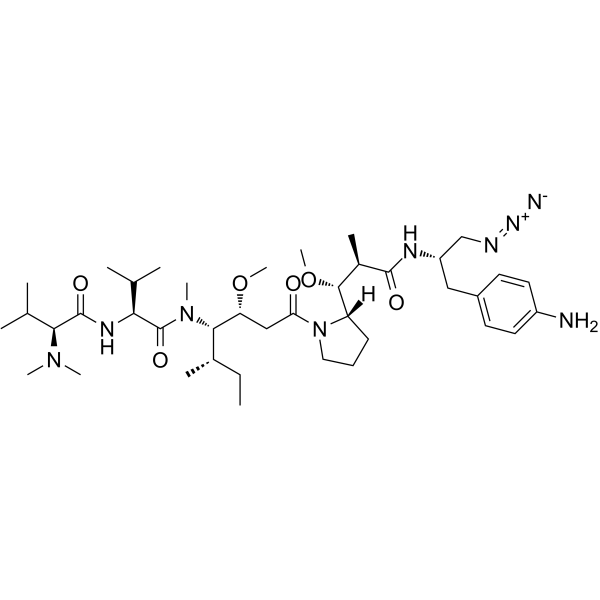Physicochemical Properties
| Molecular Formula | C40H69N9O6 |
| Molecular Weight | 772.032569646835 |
| Exact Mass | 771.537 |
| CAS # | 2124210-34-8 |
| PubChem CID | 138320017 |
| Appearance | White to off-white solid powder |
| LogP | 5.5 |
| Hydrogen Bond Donor Count | 3 |
| Hydrogen Bond Acceptor Count | 10 |
| Rotatable Bond Count | 22 |
| Heavy Atom Count | 55 |
| Complexity | 1270 |
| Defined Atom Stereocenter Count | 9 |
| SMILES | [C@@H]([C@]1([H])CCCN1C(=O)C[C@@H](OC)[C@H]([C@@H](C)CC)N(C)C(=O)[C@H](C(C)C)NC(=O)[C@@H](N(C)C)C(C)C)(OC)[C@@H](C)C(=O)N[C@H](CN=[N+]=[N-])CC1C=CC(N)=CC=1 |
| InChi Key | QIHHTRNUHMRKQK-MNFMTBGBSA-N |
| InChi Code | InChI=1S/C40H69N9O6/c1-13-26(6)36(48(10)40(53)34(24(2)3)45-39(52)35(25(4)5)47(8)9)32(54-11)22-33(50)49-20-14-15-31(49)37(55-12)27(7)38(51)44-30(23-43-46-42)21-28-16-18-29(41)19-17-28/h16-19,24-27,30-32,34-37H,13-15,20-23,41H2,1-12H3,(H,44,51)(H,45,52)/t26-,27+,30-,31-,32+,34-,35-,36-,37+/m0/s1 |
| Chemical Name | (2S)-N-[(3R,4S,5S)-1-[(2S)-2-[(1R,2R)-3-[[(2S)-1-(4-aminophenyl)-3-azidopropan-2-yl]amino]-1-methoxy-2-methyl-3-oxopropyl]pyrrolidin-1-yl]-3-methoxy-5-methyl-1-oxoheptan-4-yl]-2-[[(2S)-2-(dimethylamino)-3-methylbutanoyl]amino]-N,3-dimethylbutanamide |
| HS Tariff Code | 2934.99.9001 |
| Storage |
Powder-20°C 3 years 4°C 2 years In solvent -80°C 6 months -20°C 1 month Note: (1). This product requires protection from light (avoid light exposure) during transportation and storage.(2). Please store this product in a sealed and protected environment (e.g. under nitrogen), avoid exposure to moisture. |
| Shipping Condition | Room temperature (This product is stable at ambient temperature for a few days during ordinary shipping and time spent in Customs) |
Biological Activity
| References |
[1]. Toxin for antibody drug conjugate and preparation method thereof. CN107857798B. |
Solubility Data
| Solubility (In Vitro) | DMSO : 125 mg/mL (161.91 mM) |
| Solubility (In Vivo) |
Solubility in Formulation 1: ≥ 2.08 mg/mL (2.69 mM) (saturation unknown) in 10% DMSO + 40% PEG300 + 5% Tween80 + 45% Saline (add these co-solvents sequentially from left to right, and one by one), clear solution. For example, if 1 mL of working solution is to be prepared, you can add 100 μL of 20.8 mg/mL clear DMSO stock solution to 400 μL PEG300 and mix evenly; then add 50 μL Tween-80 to the above solution and mix evenly; then add 450 μL normal saline to adjust the volume to 1 mL. Preparation of saline: Dissolve 0.9 g of sodium chloride in 100 mL ddH₂ O to obtain a clear solution. Solubility in Formulation 2: ≥ 2.08 mg/mL (2.69 mM) (saturation unknown) in 10% DMSO + 90% Corn Oil (add these co-solvents sequentially from left to right, and one by one), clear solution. For example, if 1 mL of working solution is to be prepared, you can add 100 μL of 20.8 mg/mL clear DMSO stock solution to 900 μL of corn oil and mix evenly. (Please use freshly prepared in vivo formulations for optimal results.) |
| Preparing Stock Solutions | 1 mg | 5 mg | 10 mg | |
| 1 mM | 1.2953 mL | 6.4764 mL | 12.9529 mL | |
| 5 mM | 0.2591 mL | 1.2953 mL | 2.5906 mL | |
| 10 mM | 0.1295 mL | 0.6476 mL | 1.2953 mL |
